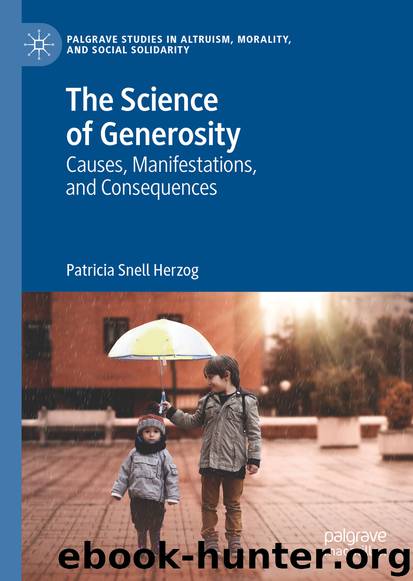The Science of Generosity by Patricia Snell Herzog

Author:Patricia Snell Herzog
Language: eng
Format: epub
ISBN: 9783030265007
Publisher: Springer International Publishing
Societal and Cultural Causes
At the broadest level of the social force pyramid, societal and cultural causes involve shared values, norms, and beliefs. Within geopolitical boundaries, subcultural dynamics affect generosity through lifestyle choices and patterned preference choices (Bourdieu 1986). For example, in the Science of Generosity projects, Li and colleagues found that social classes, in the form of occupational dynamics, affect relative generosity. In a nationally representative survey of 10,000 respondents across a ten-year time span in Britain and Wales, Li (2015a) found that there is a link between social capital and generosity. Employing a National Statistics Social-economic Classification of occupational status reveals the professional and managerial class to be more engaged in generous activities, in terms of volunteering, informal helping, and charitable giving. Specifically, about three-quarters of the professional and managerial class engaged in these generous activities, on average, compared to about two-thirds of those employed as manual labor supervisors, and about half of manual labor workers. In summary, “people in higher class positions actually give significantly more in relative terms than those in lower classes” (Li 2015a, p. 48).
Li (2015b) and Portes (1998) identify social capital as one of the great sociological “exports,” referring to the wide-scale appeal of the construct’s adoption within a variety of social science fields. Social capital can be understood in many ways, including two primary forms: as resources embedded within social networks, and as a generalized sense of social trust in others. Focusing on the first domain, Li, Savage, and Warde (2015b) studied 1564 respondents in a nationally representative survey of British households and find a relationship between social capital and cultural practices. People tend to share similar lifestyle choices with those whom they are similar to, in terms of social and economic statuses. For example, people in the professional and managerial class shared a high level of educational resources, which are highly transferred from parents to children, and education is a key predictor of cultural practices, including generosity. Cultural capital is also causal of generosity within informal social networks, which are translated into formal civic engagement activities (Li et al. 2015a).
Considering the second domain—social trust—Li et al. (2018) find that “confidence in the moral orientation or trustworthiness of fellow citizens” (p. 1) has generally been stable over time, with about half of the British population expressing social trust, in a representative study of 1595 households. People with advanced educational levels account for a greater share of those who are socially trusting, with lower shares of social trust among people with less education. Moreover, people with higher degrees of social trust are more likely to be engaged in generous activities, across a variety of social and civic engagement forms.
Similarly, another Science of Generosity project also found links between social capital and generosity. Studying more than 9464 people based in 15 European countries, Paxton et al. (2014) found religious capital contributed to greater volunteering, across multiple geopolitical and cultural boundaries. For example, Catholics in multiple countries were more likely to volunteer when they prayed in
Download
This site does not store any files on its server. We only index and link to content provided by other sites. Please contact the content providers to delete copyright contents if any and email us, we'll remove relevant links or contents immediately.
The Lost Art of Listening by Michael P. Nichols(6460)
Why I Am Not A Calvinist by Dr. Peter S. Ruckman(3765)
The Rosicrucians by Christopher McIntosh(3044)
Wicca: a guide for the solitary practitioner by Scott Cunningham(2702)
Signature in the Cell: DNA and the Evidence for Intelligent Design by Stephen C. Meyer(2495)
Real Sex by Lauren F. Winner(2466)
The Holy Spirit by Billy Graham(2408)
To Light a Sacred Flame by Silver RavenWolf(2350)
The End of Faith by Sam Harris(2277)
The Gnostic Gospels by Pagels Elaine(2022)
Nine Parts of Desire by Geraldine Brooks(2002)
Waking Up by Sam Harris(1950)
Heavens on Earth by Michael Shermer(1950)
Devil, The by Almond Philip C(1896)
Jesus by Paul Johnson(1882)
The God delusion by Richard Dawkins(1842)
Kundalini by Gopi Krishna(1820)
Chosen by God by R. C. Sproul(1754)
The Nature of Consciousness by Rupert Spira(1687)
